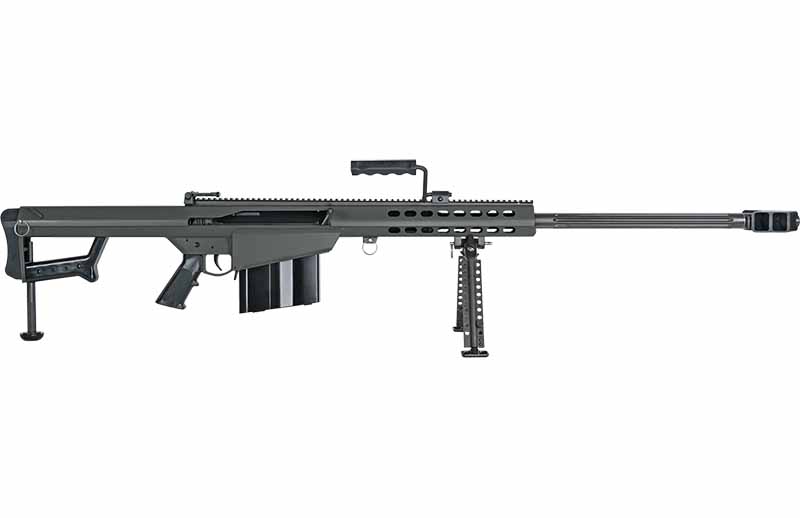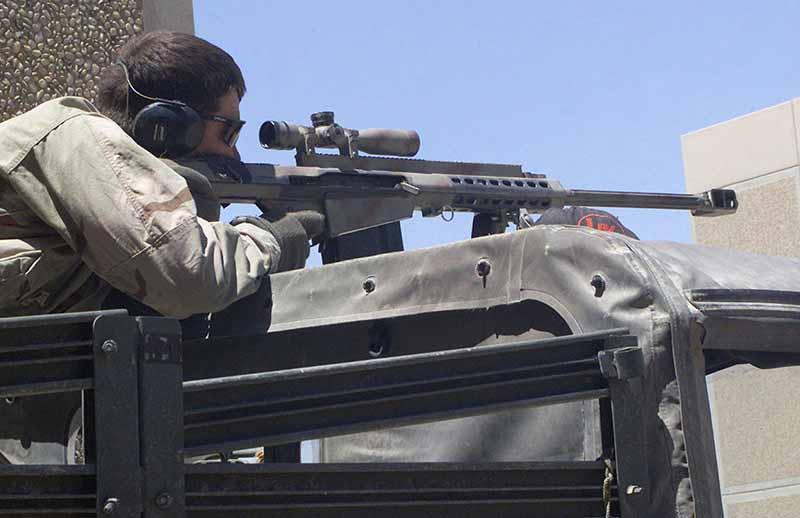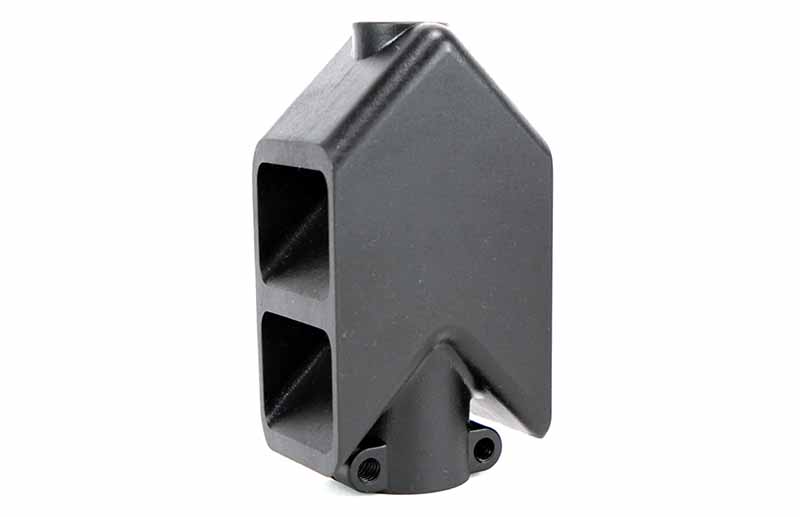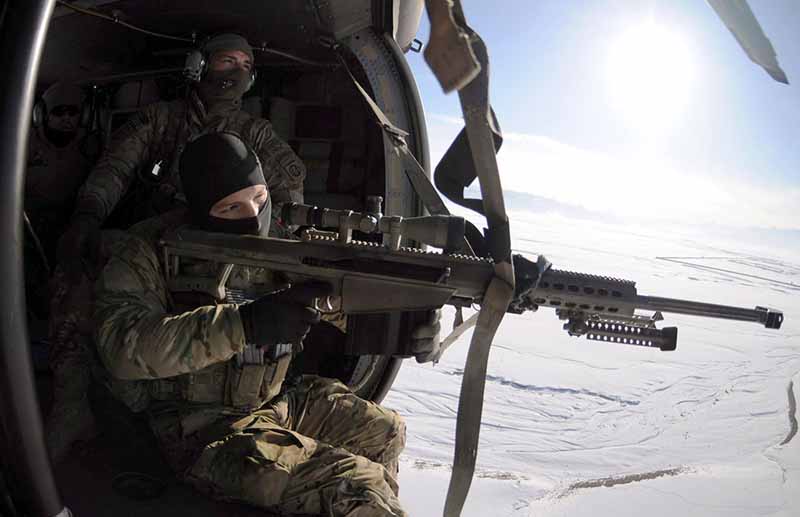
Storied as the Barrett M82 is, its reputation as the ultimate .50-cal. sniper rifle is somewhat unlikely.
What Makes The M82 Rise As A Sniper Rifle Odd:
- The rifle's original aim was as an anti-material rifle, with a limited anti-personnel role.
- Its short-recoil operation makes the rifle considerably less accurate than most suppose.
- Most .50 BMG ammunition until recent times was decidedly not match-grade.
Think of a football field with the end zones removed. Now lay 28 of them end to end. Not a football fan? How about the Houston Astro’s home, Minute Maid Park? Extend home plate to deep centerfield around 20 times.
Even with tangible and somewhat common reference points, getting a handle on exactly what 1.5 miles looks like is difficult. It’s easier to say it’s plum far. Now hit a man-sized target at this distance.

Nye impossible? In April of 2012, an unnamed soldier with Australia’s 2nd Commando Regiment tallied up a kill from this mythological distance somewhere in the mountains of Afghanistan. Technically, the second-longest recorded kill was a tick longer—2,815 yards. At these lengths, who’s counting? On his shoulder is what has come to epitomize small-unit long-range supremacy—the legendary M82A1 Barrett.
Unique and dominant, the semi-automatic has come to represent the quintessential .50-caliber sniper rifle in most people’s minds. Gun articles and movies have iconized the massive, large-caliber iron, spinning tales of death from afar, the rifle fatally biting enemies before they even hear its bark. It’s quite a reputation. One that is, in many respects, accidental.
Misunderstood Warrior
Wait … what did he say?
You heard correctly. Perhaps the most storied sniper rifle in the past 40 years fell into this role unintentionally. That’s not to say the M82—in particular the M82A1 variant (designated M107 when formally adopted in 2002)—hasn’t made hay out of the strike of serendipity. After all, the semi-automatic rifle has delivered five of the 20 longest sniper kills in history, more than any other weapon system. But picking off lone combatants and high-value, two-legged targets was never the shoulder artillery’s main aim.

Much less sexy and certainly not headline fodder, the M82 was primarily adopted into the U.S. military to smash stuff, not people. Sniper rifle in the traditional sense is a misnomer, it’s an antimaterial rifle. What the U.S. military classifies as a Special Applications Scoped Rifle (SASR) makes its biggest impact on the battlefield by sowing chaos through material deprivation. Don’t scoff. Hard-target interdiction is a big deal.
A sniper knocking a radar array or a rocket launcher out of commission has greater strategic value than dispatching any single enemy combatant—short of the top brass. Take a fighter plane, for instance. Poke a .50-caliber hole into its engine and not only have you cost the enemy a couple million. You’ve also sent a score of techs scrambling to fix it and protected your comrades from its wrath. A $2 bullet for a multi-million dollar piece of equipment; the battlefield math works out.
The Barrett M82 is more than fit for this duty. Anti-personnel engagements, on paper, it’s a bit shakier.
More Military Guns:
- Evolution Of The American Sniper Rifle
- The M1903A4 Sniper Rifle: An Old Soldier Still Hits the Mark
- M1 Garand: America’s Original Battle Rifle
- 6 Long Guns To Know From The Spanish-American War
- Five Guns You Need To Know From The American Revolution
- 8 Long Guns You Have to Know from the American Civil War
Not Quite So Accurate
Despite contrary data of its success in putting enemy combatants down for good and with authority, the .50-cal. rifle is ill-suited for this type of engagement. Quite simply, the Barrett M82 isn’t that accurate of a rifle, at least in terms of precision one-shot, one-kill attempts.
By most accounts, a stock M82 shooting M33 ball ammunition is a 3 MOA weapon. Go top-shelf on what you put into its chamber and load up match ammo, and you can expect to tighten groups to roughly 1 MOA. At 1.5 miles, this is a 55.3-inch group at the top end and an 18.4-inch group at the low end. Those numbers aren’t big shakes if your target is a 15×30-foot radar array on the back of a 40-foot truck. However, it’s less ideal when dialing in on a human target that’s a slim-nickel tall in your scope.

Much of the Barrett M82 inherent inaccuracy has to do with what makes the rifle so successful as a small-unit arm in the first place—its short-recoil operation.
To digress for a moment, pitching a 645-grain bullet with a 233-grain powder charge, the .50 Browning Machine Gun (.50 BMG or 12.7x99mm NATO) cartridge has ample kick. When hosed out of the M2 machine gun, which without its tripod weighs in at 82 pounds, this issue isn’t so noticeable. Out of a shoulder-fired weapon, the marksman is a crash test dummy every time he pulls the trigger. Rifles chambered for similar cartridges—such as the .55 Boys Anti-Tank Rifle of World War II—were reputed to abuse shoulders and detach retinas. Battlefield usefulness demands some sort of system to dampen the recoil impulse, particularly if the rifle will engage targets at long range.
The M82’s reciprocating barrel and heavy twin return springs play a prominent role in mitigating the .50-caliber’s horrible kick. Combine that with the rifle’s nearly 30-pound weight and massive muzzle brake, and you get a shootable system. Poke around YouTube some time, and you can find soldiers standing, shooting the rifle from the hip. Important as this aspect is in making the semi-auto shootable, it doesn’t exactly foster shot-to-shot consistency.
The Barrett M82 suffers the same malady of every semi-auto—particularly recoil-operated—in that it’s a different rifle with every shot. Every time the rifle fires, cycles and goes back into battery—minute as it might be—its components are in a different position from the shot prior. Including, most importantly, the barrel.
A fraction of an inch here or there might not seem like much, and it isn’t at intermediate ranges. Past a mile, it adds up.
Furthermore, until as of late, military .50-caliber ammo hasn’t exactly been up to tack-driving standards. Makes sense, it was mainly fodder for the Ma Duce and its loose chamber specs. Not exactly the recipe for a hair-splitting rifle.
How M82 Succeeds As A Sniper
Despite these drawbacks, the same snipers who use the .50-cal. rifle to knock out comm equipment and lightly armored vehicles also successfully use them to cut down enemy combatants. But how? There are a few things at play here.
It’s fair to assume military armorers have learned a thing or two about the rifle since the military began using it in the early 1990s. Thus, these skilled technicians likely have a few tricks up their sleeves to enhance the M82’s accuracy. At least, more so than when it came out of the crate.

Additionally, particularly pertaining to Afghanistan, the terrain enhanced the sniper’s ability. The rifle really had the opportunity to show its best. Unopposed shooting lanes and the advantage of elevation are every sniper's dreams. Afghanistan’s mountains offered these in spades. Three of the five long shots from the Barrett came in that corner of the world.
Then there’s a little matter of ammunition. Four of the five long shots came with the rifle pitching the Raufoss Mk 211 round. The multipurpose, anti-material round has armor-piercing capabilities and high-explosive and incendiary elements. This wicked package ensures maximum damage on a hard target.
However, it also vastly decreases the margin of error for a sniper seeking a kill.
For instance, Marine sniper Staff Sgt. Steve Richert took out three Iraqi insurgents through a brick wall at 1,765 yards utilizing the Mk 211 out of his M82. He still had to estimate where they were hidden, but he didn’t need to be dead nuts to make the shots count.
These are all important factors, improving the chances of the Barrett M82 as an anti-personnel sniper rifle. However, it overlooks perhaps the most important asset aiding the rifle’s success—the man behind the trigger. The soldier delivering these shots weren’t exactly novice marksmen. To the man, these were highly trained snipers with a full understanding of their profession, the tools of their trade and how to utilize them.

Army Spec. Nicholas Randstad, for example, shot boulders and other natural targets in his area of operation in Afghanistan. And he took meticulous notes in his dope book on exactly how his M82 performed in any given circumstance and in the face of any variable. When the Taliban set to attack the road crew he was providing overwatch, he was able the defuse the situation with a 2,288-yard kill. More so than the rifle’s reach, his knowledge is what put him on target.
On paper, the Barrett .50-caliber seems an improbable candidate to go down as one of the great sniper rifles. That doesn’t matter. Wars aren’t fought with rifle specs and engineering perimeters. When the rubber hit the road and life was in the balance, the M82 performed in the hands of a motivated sniper. That’s enough to cement it among the greats.
Barret M82 Variants
M82: .50 BMG recoil-operated semi-auto rifle, with a 10-round detachable box magazine and flip-up sights.
M82A1: Improved variant with redesigned muzzle brake, designated M107 when formally adopted by the military in 2002.
M82A1A: Optimized for the Raufoss Mk 211 round.
M82A1M: Lengthened accessory rail, includes rear grip and monopod socket.
M82A2: Shoulder-mounted bullpup variant.
M82A3: New production rifles built to M82A1M specifications. Accessory rail is usually, but not always, raised higher up than the M82A1M/M107. It does not include a rear grip and monopod socket.

Next Step: Get your FREE Printable Target Pack
Enhance your shooting precision with our 62 MOA Targets, perfect for rifles and handguns. Crafted in collaboration with Storm Tactical for accuracy and versatility.
Subscribe to the Gun Digest email newsletter and get your downloadable target pack sent straight to your inbox. Stay updated with the latest firearms info in the industry.

![Best Concealed Carry Guns In 2025 [Field Tested] Wilson Combat EDC X9S 1](https://gundigest.com/wp-content/uploads/Wilson-Combat-EDC-X9S-1-324x160.jpg)


![Best 9mm Carbine: Affordable PCCs [Tested] Ruger Carbine Shooting](https://gundigest.com/wp-content/uploads/Ruger-Carbine-Shooting-100x70.jpg)
![Best AR-15: Top Options Available Today [Field Tested] Harrington and Richardson PSA XM177E2 feature](https://gundigest.com/wp-content/uploads/Harrington-and-Richardson-PSA-XM177E2-feature-100x70.jpg)

M82/107 is not a pin-point accurate firearm….2-4MOA is correct. (Newer M107A1 is actually around 1MOA with capable consistent ammo.) However, I will guarantee that a 660gr M33 ball round impacting within that 2-4MOA WILL smartly encourage one to find a hole….or instantly dig one…..to place one’s self deep within…… GUARANDAMNTEED!!! The .50BMG M82/107 is to be replaced by Barrett MRAD bolt action change barrel MK22 firing the .338 Norma Magnum as the anti-material round. (.300 Norma Magnum for anti-personnel extended range; .308Win for range practice and closer personnel engagements.) With the new developments in 338NM rounds, it will provide improved accuracy with essentially equal on target terminal mayhem. Shooter can run MK22 bolt and get back on target to spot impacts during flight time at extended range. MRAD is half the weight of the M82/107 with ammo being lighter llowing more ammo to be humped. As much as the grunts love the .50, its weight means it gets left in the armory too often on mountain patrols. Personally have both M107A1 and MK22…..not cheap to buy or feed, but extremely high smile per bang value. 🙂 🙂 🙂